|
|
|
Sort Order |
|
|
|
Items / Page
|
|
|
|
|
|
|
| Srl | Item |
| 1 |
ID:
126430
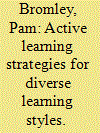

|
|
|
|
|
| Publication |
2013.
|
| Summary/Abstract |
Although political science instructors increasingly recognize the advantages of incorporating active learning activities into their teaching, simulations remain the discipline's most commonly used active learning method. While certainly a useful strategy, simulations are not the only way to bring active learning into classrooms. Indeed, because students have diverse learning styles-comprised of their discrete learning preferences-engaging them in a variety of ways is important. This article explores six active learning techniques: simulations, case studies, enhanced lectures, large group discussion, small group work, and in-class writing. Incorporating these activities into an introductory, writing-intensive seminar on globalization and surveying students about their engagement with course activities, I find that different activities appeal to students with different learning preferences and that simulations are not students most preferred activity. Bringing a broader range of active learning strategies into courses can improve teaching for all students, no matter their learning style.
|
|
|
|
|
|
|
|
|
|
|
|
|
|
|
|
| 2 |
ID:
117585
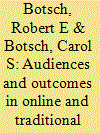

|
|
|
|
|
| Publication |
2012.
|
| Summary/Abstract |
In 1997 we first offered American government classes online as well as face-to-face classes. We administered pre- and posttests to our students to measure their general knowledge of American government, political attitudes, demographics, and some behaviors. Following an initial report in 2001, we continued to gather data for 10 more years; this current study covers nearly 3,200 students during 13 years. We examine the sample as a whole and changes in audiences and outcomes, over time, for the two teaching formats. Although the kinds of students taking online classes have become more similar, a few differences persist. Learning outcome differences continue to be insignificant. Neither format has a clear advantage in students' changes in attitudes, but the online classes increased students' newspaper reading. Class dropout rate and faculty workload both favor face-to-face classes, but flexibility in scheduling and student demand clearly favor online classes.
|
|
|
|
|
|
|
|
|
|
|
|
|
|
|
|
| 3 |
ID:
131742
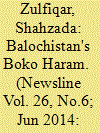

|
|
|
|
|
| Publication |
2014.
|
| Summary/Abstract |
The rise of a new extremist outfit in Balochistan has forced the closure of private school's in the district of Panjgur. Teachers, parents and students are calling out the local administration for capitulating to extremists in a region which already lags behind in education compared to other provinces.
|
|
|
|
|
|
|
|
|
|
|
|
|
|
|
|
| 4 |
ID:
173176
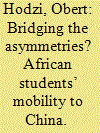

|
|
|
|
|
| Summary/Abstract |
African students’ mobility to China is growing – making China the second most popular destination for African students studying abroad, after France. Generally, due to the pervasive poverty and inequality in African states, educational mobility is a means to escape individual socio-economic challenges for the transformation of lives. However, is the African students’ mobility to China able to achieve those expectations? Through a critical analysis of current scholarship in African student education mobility the paper explores the underlying material and ideational motivations of China’s education support in Africa. In probing Africans’ educational mobility to China, the paper pushes the boundaries of enquiry beyond the surface of affordable education. Examining the asymmetries emerging from African students’ mobility to China and questioning the bridging effect of educational mobility, the paper finds that education aid and development in Africa have always been a factor of external powers’ domestic and foreign interests.
|
|
|
|
|
|
|
|
|
|
|
|
|
|
|
|
| 5 |
ID:
137596
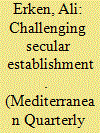

|
|
|
|
|
| Summary/Abstract |
Student movements in the twentieth century Middle East have received less attention than many other topics in the study of the region's cultural and political history. Yet the rapidly changing demographic composition of the region since the 1960s have made young people and youth activism a significant parameter in Middle Eastern politics, highlighted by the Arab Spring that began in late 2010. Student movements in Turkey and Egypt gained momentum in the 1960, and in the 1970s Islamic discourse became increasingly popular among young activists. These youth movements operated through flexible structures, allowing them to challenge the state authority and secular statecraft. This essay explores three of the leading religious and nationalist student movements in Turkey and Egypt in the 1970s.
|
|
|
|
|
|
|
|
|
|
|
|
|
|
|
|
| 6 |
ID:
184395
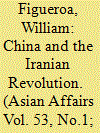

|
|
|
|
|
| Summary/Abstract |
This article examines several under-explored aspects of Sino-Iranian relations in the 1970s, the process of Sino-Iranian rapprochement, and China's reaction to the 1979 revolution. By relying on sources in both Chinese and Persian and pushing back the timeline to 1965, it analyses the role of China's unofficial support for Iranian Maoism on official relations, the personal role of the Shah and the women of the royal family, China's internal view of the Islamic Republic shortly after 1979, and the role of propaganda and performativity in Sino-Iranian diplomacy. In doing so, it sheds new light on old topics and expands on previous studies that focus primarily on the official politics of rapprochement and the post-1971 era.
|
|
|
|
|
|
|
|
|
|
|
|
|
|
|
|
| 7 |
ID:
178394
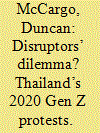

|
|
|
|
|
| Summary/Abstract |
This article offers a preliminary analysis of the hundreds of youth-inspired mass protests staged in Thailand during 2020. It argues that while calling for reforms and flirting with revolutionary rhetoric, the protestors lacked a clear programmatic agenda and were primarily engaged in disrupting dominant narratives about the country’s politics, especially in relation to the previously taboo question of the political role of the monarchy. Despite the ad hoc and sometimes incoherent nature of the protests, the students mounted a dramatic challenge to Thailand’s ruling elite. Ultimately, the conflict exemplified a generational divide: people from Generation Z, aged under 25, have radically different understandings of power, deference and legitimacy from older population groups. Whatever happens to the protest movement in the short term, the demonstrators have made a decisive break with the old social consensus that existed during the long reign of the late King Bhumibol (1946–2016).
|
|
|
|
|
|
|
|
|
|
|
|
|
|
|
|
| 8 |
ID:
117855
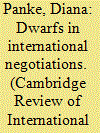

|
|
|
|
|
| Publication |
2012.
|
| Summary/Abstract |
Students of international relations interested in cooperation through international regimes and organizations very often devote their attention to the role of a few big states rather than the numerous small ones. Small states tend to possess fewer administrative and financial resources back home as well as smaller and less well-equipped delegations at the international negotiation table than big states. This can easily translate into difficulties in preparing positions for all items on the negotiation agenda and in developing negotiation strategies in great detail, which might inhibit small states from successfully influencing negotiation outcomes. Yet, since international negotiation often rest on a one-state, one-vote principle and since small states can adjust priorities and redirect their limited capacities, there is a window of opportunity for small states to turn into important international actors and achieve significant outcomes in international affairs. In order to systematically shed light on the role of small states in international negotiations, this article outlines the conceptual framework to answer the following question: How, and under which conditions, can small states successfully punch above their weight in international negotiations?
|
|
|
|
|
|
|
|
|
|
|
|
|
|
|
|
| 9 |
ID:
186830
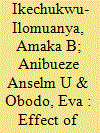

|
|
|
|
|
| Summary/Abstract |
Limited literature exists on how to improve classroom concentration (CC) of survivors of kidnapping. The current study extends the literature in this direction through a quasi-experiment involving 470 schoolchildren (SC) who survived kidnapping in the last one year. The result of the study showed that SC who received counseling through a visual multimedia (VM) package reported more CC than their counterparts who received counseling through face-to-face setting. The study concludes that VM is a cost-effective way of improving CC of SC who are survivors of kidnapping.
|
|
|
|
|
|
|
|
|
|
|
|
|
|
|
|
| 10 |
ID:
092563
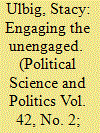

|
|
|
|
|
| Publication |
2009.
|
| Summary/Abstract |
As the nation witnesses a distinct decline in civic engagement among young adults, political science instructors across the nation face the formidable task of engaging students in lower-level, general education courses outside students' primary domain of interest. The research presented here seeks to understand if visually enhanced lecture material can effectively engage such students better than more traditional methods of classroom delivery. The project utilizes an experimental design involving two different sections of the same introductory American government course. By exposing the sections to different visual presentations, and controlling for a variety of potentially confounding factors, the impact that simple visual images have on student engagement both inside and outside the classroom are isolated. Findings suggest that the use of simple visual images can enhance students' impressions of the discipline of political science and boost their interest in and knowledge of politics and public affairs more generally.
|
|
|
|
|
|
|
|
|
|
|
|
|
|
|
|
| 11 |
ID:
113997
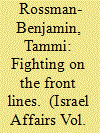

|
|
|
|
|
| Publication |
2012.
|
| Summary/Abstract |
Members of Muslim and pro-Palestinian student organizations and anti-Zionist faculty are the two main sources of anti-Jewish bigotry at the University of California (UC), and their behaviour has had two primary effects: the anti-Semitic language and imagery used by these individuals has caused significant harm to the reputation of Israel and its supporters, both on and off campus; and their behaviour has created a hostile and threatening environment for many Jewish students on UC campuses. Efforts to address the problem of anti-Semitism on UC campuses have generally targeted one of these two effects. These efforts have included: the reactive and proactive campaigns of pro-Israel student and faculty groups, as well as attempts to secure the protection of Jewish students from anti-Semitic harassment through legal means and by applying grassroots pressure on UC administrators. Although none of the efforts has led to a substantial reduction of anti-Semitism on UC campuses, a few of the approaches show some promise.
|
|
|
|
|
|
|
|
|
|
|
|
|
|
|
|
| 12 |
ID:
095923
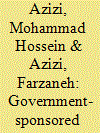

|
|
|
|
|
| Publication |
2010.
|
| Summary/Abstract |
The first Iranian to study medicine abroad was sent to Britain by the Iranian government in 1811, during the early decades of the Qajar period (1796-1925). The second student was sent to France in 1815, along with four other students. Another group of five students, including the third student of medicine, was sent to France in 1845. Forty-two others, including five medical students, were dispatched to France in 1858. Most members of the latter group were among the first graduates of Tehran Dar al-Fonun (House of Techniques) School. Then, in 1928, during Reza Shah Pahlavi's reign (1925-41), a special act was passed by the Iranian parliament (Majlis) according to which the Ministry of Education would send 100 students abroad annually for higher education at the government's expense. The practice was suspended in 1935 with the advent of the Second World War. Between 1928 and 1935, a total of 640 students, including 125 medical students, were sent abroad. The majority of the medical students (84 percent) were sent to France. Most of these medical graduates returned to Iran and in subsequent years played a significant role in further propagation of modern medical knowledge in the country. The paper presents a brief historical account of the conditions of public health and medical education between 1811 and 1935 as well as biographical sketches of some of the best-known or most influential medical figures among these graduates.
|
|
|
|
|
|
|
|
|
|
|
|
|
|
|
|
| 13 |
ID:
136710
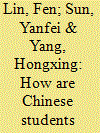

|
|
|
|
|
| Summary/Abstract |
Students have always played an important role in defining the politics of China, and their ideological orientation shapes the nature of student politics. Through a survey of students from six elite universities, this study explores the outlook of Chinese youth’s political identities and analyzes the factors conditioning their identity formation. The results reveal three trends. First, the majority of these college students either claim themselves to be apolitical or to be liberals. Second, among various channels of political (re)socialization, family plays a weak role, while mass media has a strong influence on students’ political orientation. Peking University, the base for nurturing liberals in the 1990s, has now yielded this role to universities specializing in economics and finance, thus suggesting the impact of economic liberalism since the 1990s. Third, gender, education level, academic major, family income, and Communist Party membership are all good indicators of students’ political identities. These results are interpreted in the context of student movements and intellectual transition in China over the past four decades.
|
|
|
|
|
|
|
|
|
|
|
|
|
|
|
|
| 14 |
ID:
092554
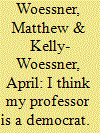

|
|
|
|
|
| Publication |
2009.
|
| Summary/Abstract |
Notwithstanding political science professors' concerted efforts to remain politically neutral in the classroom, we find evidence that students are able to successfully identify the partisan loyalties of their professors. Furthermore, we find that there is a tendency for students to drift toward the Democratic Party over the course of the semester, yet the direction of the shift appears to be unrelated to either the instructor's actual political loyalties, or to the student's perception of the professor's partisan preferences. Given that political science professors appear to exert no real influence on students' party loyalties, it is unclear whether efforts to diversify the field by hiring more Republican professors would actually reduce the "liberalizing" effects of higher education.
|
|
|
|
|
|
|
|
|
|
|
|
|
|
|
|
| 15 |
ID:
184212
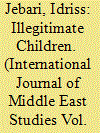

|
|
|
|
|
| Summary/Abstract |
The alliance between the leftist movement Perspectives Tunisiennes and university students delivered sustained opposition and repeated protests against Bourguiba's regime in the 1960s and 1970s. This article argues that these groups were driven by the “student question,” a counterproject for Tunisian national development that opposed the vision of liberal bourgeois modernity espoused by Bourguiba's reforms of elitism through education and depoliticization. Instead, the student question was fleshed out in the group's periodical, envisaging the emancipation of Tunisian subjects and their entitlement to citizenship and political participation, and how the struggle of students would sweep the whole country. Drawing on the movement's journal and memoirs of four former Tunisian leftists, I trace how Perspectives navigated the regime's repression in 1968 and 1972–75, and how two successive generations of leftists emerged with different ideological reference points. In so doing, this article takes seriously the political imagination of this group during the global 1960s and 1970s, while conceiving ways to reintegrate silenced memories and histories into the mainstream of Tunisian historiography after the 2011 revolution.
|
|
|
|
|
|
|
|
|
|
|
|
|
|
|
|
| 16 |
ID:
122952


|
|
|
|
|
| Publication |
2013.
|
| Summary/Abstract |
How do Chinese scholars and students residing in the United States view the United States? This study tries to answer this question using a unique dataset from the United States. It also seeks to identify the determinants of Chinese migrants' attitudes towards the United States, especially with regard to overseas socialization. On the whole, the results indicate that Chinese scholars and students in the United States have a mostly favourable attitude towards America and remain positive towards China. Their values, overseas experience, and other factors have important influences on their feelings towards the United States. We find that most respondents have a positive attitude towards the United States, as regards both its general national image and diverse images, including political institutions, the economy, and the environment. We also find that this group of Chinese respondents maintains a strong attachment to China and has a conservative attitude towards China's future growth. Our results suggest that values such as nationalism and ethnocentrism have significant influence on individuals' feelings towards the United States.
|
|
|
|
|
|
|
|
|
|
|
|
|
|
|
|
| 17 |
ID:
145073
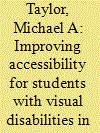

|
|
|
|
|
| Summary/Abstract |
As higher education has increasingly embraced digital technologies, we have been too slow to acknowledge accessibility issues for students with visual disabilities. One of the earliest promises of information and communication technology was increased accessibility to content. In theory, digitized content should be as equally accessible as the printed word on a screen, a braille keyboard, or an audible voice on a speaker. In the majority of educational technology, this promise has gone unfulfilled, and faculty members are largely unaware of the myriad obstacles that students with visual disabilities confront while navigating the technology-rich classroom. The principles of Universal Design in Instruction (UDI) provide guidance for developing curriculum that maximizes accessibility and usability of course content for all learners, including those with disabilities. This article examines the development of political science courses through the lens of UDI.
|
|
|
|
|
|
|
|
|
|
|
|
|
|
|
|
| 18 |
ID:
161698
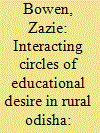

|
|
|
|
|
| Summary/Abstract |
Children from rural Odishan Scheduled Tribe and Scheduled Caste communities have an historically marginalized relation to schools and a corresponding greater involvement with informal education regimes and participation in everyday economic and cultural routines. Although radical state restructuring in recent decades makes rural school buildings more visible, inside the classrooms, students were often present and teachers absent. Drawing on ethnographic fieldwork, in Western Mayurbhanj, Odisha, I examine students’ engagement with school and argue that rural schools cannot be fully understood without examining the motivations of and interactions between three sets of stakeholders: state, local providers, and students. Further, the motivations, evaluations, and experiences of students deserve to be brought much more to the fore in light of their active roles in Mayurbhanj village schools and the significant effects of this involvement on both the nature of rural schools and the changes in rural blocks.
|
|
|
|
|
|
|
|
|
|
|
|
|
|
|
|
| 19 |
ID:
154500
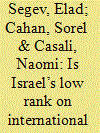

|
|
|
|
|
| Summary/Abstract |
Israel’s consistently low ranking on international achievement tests has been exclusively attributed to insufficient investments in education or inefficient use of available resources. In contrast, this article shows this low ranking to be a true reflection of Israel’s reality in terms of characteristics that affect the mean ability of its student population to profit from schooling (MAPS). Israel’s actual ranking on the PISA test among the 34 OECD member countries (the lowest decile, in the company of Mexico and Turkey) perfectly matches its expected rank on the basis of MAPS (operationally defined as the proportion of children above the ‘poverty line’).
|
|
|
|
|
|
|
|
|
|
|
|
|
|
|
|
| 20 |
ID:
170705
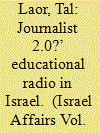

|
|
|
|
|
| Summary/Abstract |
Educational radio stations in Israel, which have operated for at least 25 years, are inspired by the American college radio. This article investigated the functions and contributions of radio to students and to the media industry in general and radio broadcasts in particular. A research survey was distributed on aspects of the media industry and interviews with educational radio activists were conducted. The findings indicate that schools of communication believe and invest in integrating practical experience. As a result, students acquire abilities and practical skills as well as knowledge of the communications world. Students operate educational radio stations with high levels of motivation and self-fulfillment. These student efforts and support from academic institutions bear fruit as the media industry acknowledges the value of educational radio studies graduates and appreciates their preparedness to integrate into the industry.
|
|
|
|
|
|
|
|
|
|
|
|
|
|
|
|
|
|
|
|
|